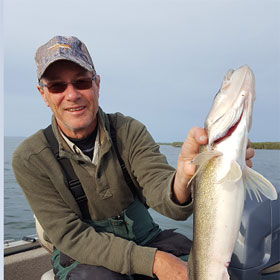Buying Tips for Getting into Ice Fishing
By C.B. Bylander
Dec 18, 2019
Ice fishing continues to grow in popularity in Minnesota. Those who want to experience ice fishing have a range of equipment options, including low-, medium- and high-priced options.
Are you thinking of getting into ice fishing?
If so, you will be riding a growing wave.
That’s because ice fishing is more popular than ever. Gone are the sit-on-a-bucket-and-freeze-your-behind days. Instead, modern ice fishing is largely about toasty pop-up shelters, high-tech fish-finding electronics and winter fun with friends and family.
So what to buy and where to start?
Frankly, you can get into ice fishing for dirt cheap by simply repurposing reels, line, sinkers, bobbers, lures, hooks and other gear from open water fishing. Alternately, you can drop $40,000 on a fancy wheel house complete with big screen television, bathroom, beds and kitchen facilities. Your options vary. So let’s explore them.
No cost option
The absolute cheapest way to get into ice fishing is to chum along with someone who has all of the equipment. Obviously, this isn’t a long-term solution but the reality is that most anglers will gladly share their equipment with you, and they’d love to have company on the ice. You’ll want to have your own warm waterproof boots, gloves, hat and layered outerwear. Also, you will want to bring snacks to share, a beverage or two and a flashlight so you can see tiny lures and thin line in low-light conditions.
Low cost option
Let’s call “low cost” about $100. That amount will fund your basic equipment needs though you will still need someone to drill a hole for you. Good hand augers are in the $80 range and power augers are commonly in the $300 to $600 range. Recommended low cost purchases include an entry level ice fishing rod and reel ($25), line ($5), an assortment of lures ($15), slip bobbers and bobber stop knots ($5), variety pack of sinkers ($5) ice seining scoop ($5), tip-up reel ($20), tip-up reel line, leader and hooks ($10), plastic bucket or chair to sit on ($5 to $20), and a lake contour map app for your smartphone (anywhere from free to $50).
Other low-cost handy things to have include a minnow scoop, bait puck for wax worms or grubs, slip-on ice cleats, face mask and waterproof gloves. A pricier piece of equipment ($30 to $50) that is also good to have is an ice chisel. Ice chisels are handy for chopping open iced-over holes and to determine ice depth. The latter is done by stabbing the ice hard. If the chisel pops through the ice you are, literally, on thin ice and need get off it.
Medium cost option
Medium cost options include all of the low cost items listed above plus items that mean you are truly making a commitment, namely an auger, pop-up shelter and sonar unit. Gas-powered augers typically cost $300 to $600. Battery-powered augers are about the same. Portable fish shelters run anywhere from a few hundred dollars to about $1,000. Basic ice fishing fish locators are in the $300 to $500 range and those sonar units with GPS capability are priced slightly higher. Underwater cameras typically cost a few hundred dollars. Portable heaters can be had for about $100 or less. Budget $50 to $100 for a deep sturdy sled to carry your gear.
The all-in option
One of the reasons ice fishing is growing in popularity is that the cold factor is diminishing. Yes, you may get chilled while setting up and drilling holes but once that is done insulated shelters and modern wheeled fish houses allow anglers to fish in balmy temperatures. Upscale wheeled fished house cost $20,000 to $40,000. High-end ice fishing rods and reels can top $100. Another option is to rent. Check out rental and guide options on Explore Minnesota.










